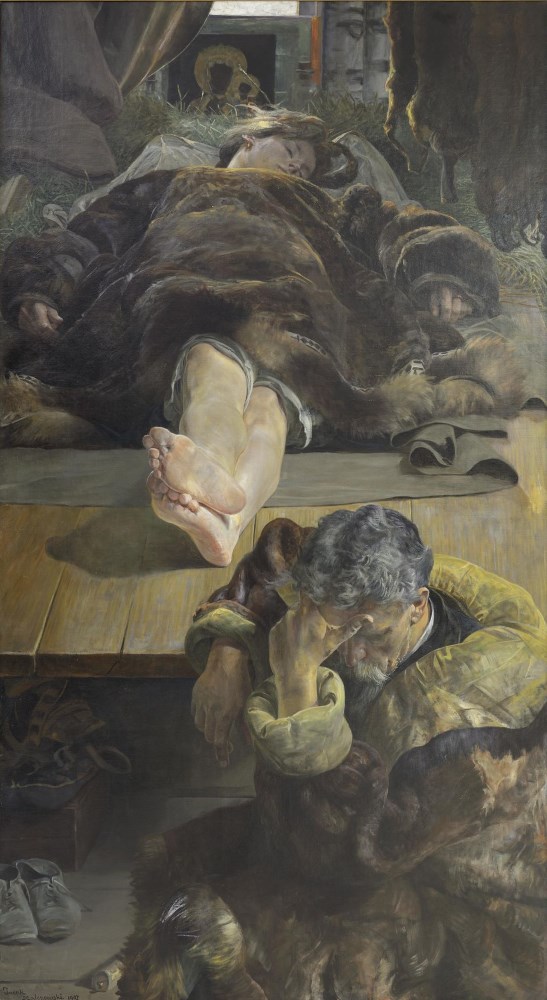Description:
Jack Malczewski (1854-1929) had a love for art and romantic literature, especially the poetry of Julius Słowacki, which he inherited from his family home. He came from a shla-checkie family, although not wealthy. His father Julian supported him on his way to a career in painting. The events of 1863, the January Uprising and subsequent repression, left a deep impression on the young artist. His first teacher was Adolf Dygasiński. He spent his youth from 1867 to 1871 at the Karczewskis’ manor in Wielgie. In 1873 he began his studies at the Academy of Fine Arts in Krakow under the tutelage of Jan Matejko. He was a student of Władysław Łuszczkiewicz. He also studied at the École des Beaux-Arts in Paris. He traveled to Italy, Vienna, Munich, Greece and Minor Asia. From 1896 to 1900 and 1910 to 1914 he was a professor at the Academy of Fine Arts in Krakow. From 1912 to 1914 he was its rector. He began with idealizing realism, then naturalism, and the main theme of his works during this period was the fate of the exiles in Siberia and the inspirations of Julius Słowacki’s “Anhellim”. Fantastic and allegorical views began to appear in Malczewski’s work simultaneously. After his father’s death in 1884, the recurring motif in Malczewski’s work was Thanatos – the god of death. After 1890 his art became completely symbolic. The works manifesting the turn towards a symbolist style are: “Introduction” 1890, “Melancholia” 1890-1894, “False Circle” 1895-1897. The artist addressed existential, historical and artistic topics, intertwining Ancient and Biblical motifs with local folklore and the Polish landscape so important in his works. Form, color, monumentality of the representations and their expressiveness became his trademarks.
Description of the painting:
Malczewski painted a scene of the death of one of the characters of the poem “Anhelli” by Juliusz Słowacki. It is an illustration of the poet’s words: “Anhelli did not dare to move the dead body, nor to put his hands, which were stretched out, but sitting at the end of the bed he wept”. The violent perspective leads the viewer’s eyes to the feet of the deceased, which seem to be the central point of the presentation. In the formal solution used here we can see references to Mantegna’s work “Lamentation of Christ”. In the figure of Ellenai, we can see a similarity to the great love of the painter – Maria Balowa. The man grieving at her bedside is Malczewski himself, mourning the loss of his beloved and only companion of misery.
“Ellenai” is the heroine of Juliusz Słowacki’s poem “Anhelli”. You can read about Malczewski’s fascination with the works of this outstanding Polish poet in the description of the triptych for “Beniowski” or the painting “We’ll Go Together”. The Ellenai theme appeared on Jacek Malczewski’s paintings several times. In 1882 he painted “Death of the Exile”, in 1883 – “Death of Ellenai”. The creation of another “Death of Ellenai” in 1907 was a result of the events of 1905 and the artist’s expectations of Poland regaining independence related to the political unrest.
Slovak presented the story of the heroes’ journey through the white, Siberian hell. Anhelli as the “man angel”, sinless, was chosen by the Shaman as the Saviour of the nation. He begins a journey through the snowy wilderness, like the hero of Dante’s “Divine Comedy” traversing the circles of hell. He meets the damned, beaten, persecuted and divided. He is alone. He desires the company of someone who will share in his suffering. The chosen Saviour turns out to be a criminal – Ellenai. The woman converts, leaves the path of evil deeds, tries to redeem her sins and showers the hero with true sisterly love. She is often compared to Mary Magdalene. In reward for the penance and humility she performed, after death, accompanied by an angel, she reaches heaven. Yet Anhelli suffers, remaining alone here on earth, abandoned by the only being who understood him and loved him.
Ellena’s face has the features of the great love of Malczewski’s Maria Balowa. Thus, the painter himself becomes a Young Polish Anhellim, Maria Balowa – Ellena. The artist has not only presented the Savior of the Nation created by Słowacki, harshly punishing the rebellious brothers, but also a desperate man whose beloved had left him forever. After years of endless artistic struggle and involvement in the national-emancipation topics, did not the artist have the right to portray himself, the Malczewski-artist and the lonely and desperate Malczewski-man, alongside the painted dead and beloved muse?


